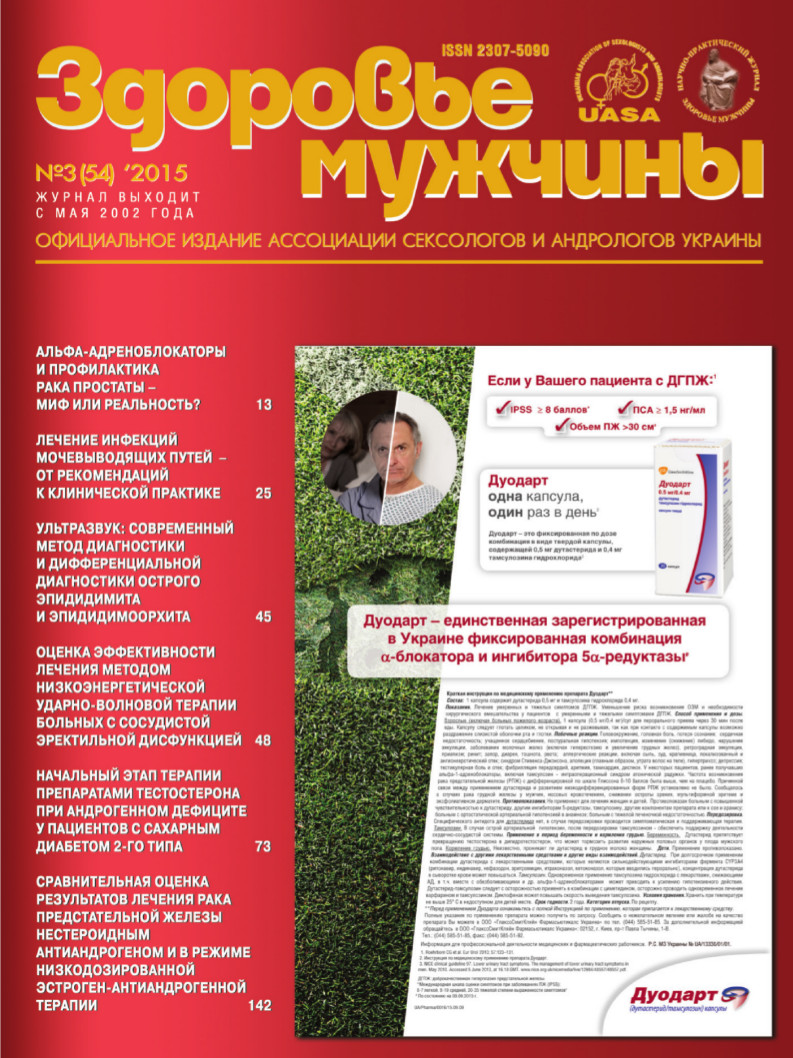Contemporary aspects of the diagnostics and conservative treatment of the lower urinary tract symptoms caused by BPH
##plugins.themes.bootstrap3.article.main##
Abstract
Lower urinary tract symptoms (LUTS) are referred to a group of medical symptoms that affect approximately 40% of men of older age and significantly affect their quality of life. Benign prostatic hyperplasia (BPH) is known to be the main cause of LUTS. Clinical manifestations caused by BPH are observed in 10% of men in the age group under 40 years old and in 40–61% of men under 70 years old. The objective of our study was to evaluate the efficacy and safety of Tamsulosin (Omnik, Astelas) in patients with LUTS caused by BPH. The study included 39 patients with LUTS against the background of BPH. The mean age of patients was 65.2±4.2 y. The criterion for inclusion into the study was the diagnosis of BPH, established on the basis of clinical symptoms, anamnesis, physical examination, the results of questionnaire by IPSS scale, quality of life index QoL, urinalysis, PSA, prostate and urinary tract ultrasound findings with determination of
the residual urine volume after urination, uroflowmetry data LUTS severity had decreased in the majority of patients following treatment with Omnik in dosage of 0.4 mg daily for 12 weeks. We have obtained statistically significant changes in the scores on the IPSS scale (International Prostate Symptom Score): prior to treatment 19.8±3.2 points, and at 12th week after treatment – 10.5±2.7 points. Changes in the maximum urine flow rate Qmax under the treatment demonstrated high efficiency of Omnik (before treatment – 6.6 ml/s, at the 4th week after treatment – 8.3 ml/s and at 12th week after treatment – 10.1 ml/s). There was a direct correlation between the effectiveness of LUTS treatment and duration of Tamsulosin administration. At that adverse effects occurred were rare, mild and did not require discontinuation of treatment or specific treatment.
##plugins.themes.bootstrap3.article.details##

This work is licensed under a Creative Commons Attribution 4.0 International License.
Authors retain the copyright and grant the journal the first publication of original scientific articles under the Creative Commons Attribution 4.0 International License, which allows others to distribute work with acknowledgment of authorship and first publication in this journal.
References
Abrams P, et al. The standardisation of terminology of lower urinary tract function: report from the Standardisation Subcommittee of the International Continence Society. Neurourol Urodyn, 2002. 21 (2): p. 167–78.
Chapple CR, et al. Lower urinary tract symptoms revisited: a broader clinical perspective. Eur Urol, 2008. 54 (3): p. 563–9.
Novara G, et al. Critical Review of Guidelines for BPH Diagnosis and Treatment Strategy. Eur Urol Suppl 2006. 4: p. 418–29.
Martin SA, et al. Prevalence and factors associated with uncomplicated storage and voiding lower urinary tract symptoms in community-dwelling Australian men. World J Urol, 2011. 29 (2): p. 179–84.
Societe Internationale d’Urologie (SIU), Lower Urinary Tract Symptoms (LUTS): An International Consultation on Male LUTS. C. Chapple and P. Abrams, Editors. 2013.
Kupelian V, et al. Prevalence of lower urinary tract symptoms and effect on quality of life in a racially and ethnically diverse random sample: the Boston Area Community Health (BACH) Survey. Arch Intern Med, 2006. 166 (21): p. 2381–7.
Agarwal A, et al. What is the most bothersome lower urinary tract symptom? Individual– and population-level perspectives for both men and women. Eur Urol, 2014. 65 (6): p. 1211–7.
Taub DA, et al. The economics of benign prostatic hyperplasia and lower urinary tract symptoms in the United States. Curr Urol Rep, 2006. 7 (4): p. 272-81.
McVary KT, et al. Update on AUA guideline on the management of benign prostatic hyperplasia. J Urol, 2011. 185 (5): p. 1793–803.
Bosch J, et al. Etiology, patient assessment and predicting outcome from therapy. In: Chapple C, Abrams P, editors. Male lower urinary tract symptoms. Montreal, Canada: International Consultation on Urological Diseases Male LUTS Guideline, 2013. p. 37–133.





